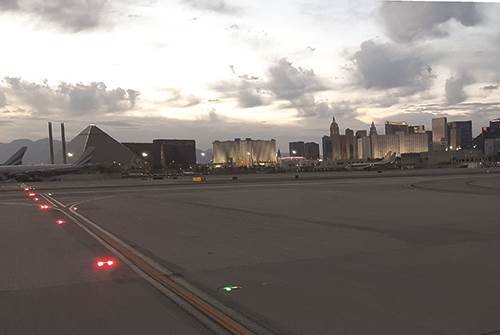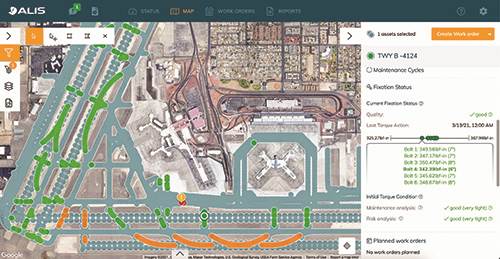Maintenance personnel at McCarran International Airport (LAS) no longer put pen to paper when they log maintenance performed on runway lights. Instead, a digital asset management system uses GPS technology to track the work performed and pushes the information to a cloud-based platform to enhance the accuracy of maintenance records.
Maintenance personnel at McCarran International Airport (LAS) no longer put pen to paper when they log maintenance performed on runway lights. Instead, a digital asset management system uses GPS technology to track the work performed and pushes the information to a cloud-based platform to enhance the accuracy of maintenance records.
 Doug McMahan, assistant director of facilities/management at the Clark County Department of Aviation, reports that the Airfield Location-based Inspection and Service system (ALIS) from ADB SAFEGATE increases operational efficiency by reducing human errors and minimizing runway downtime. It also helps ensure that maintenance of airfield lighting complies with FAA standards and makes it easier for the agency to review maintenance records during annual audits.
Doug McMahan, assistant director of facilities/management at the Clark County Department of Aviation, reports that the Airfield Location-based Inspection and Service system (ALIS) from ADB SAFEGATE increases operational efficiency by reducing human errors and minimizing runway downtime. It also helps ensure that maintenance of airfield lighting complies with FAA standards and makes it easier for the agency to review maintenance records during annual audits.
“We have limited time and staff,” McMahan says. “So from a work management perspective, this technology maximizes our efficiency. For example, we can specify runway closure times much more accurately and reduce [them] because we now know exactly how long it takes to bolt down cans in a runway closure area. Instead of relying on institutional knowledge, we know exactly how long the work will take.
|
Project: Asset Tracking System Location: McCarran Int’l Airport, Las Vegas 2020 Volume: 22.2 million passengers System: ALIS (Airfield Location-based Inspection and Service) Vendor/Consultant: ADB SAFEGATE Approx. Cost: $100,000, plus $15,000 annual subscription fee Funding: General airport revenue Installation: Late 2019 Airfield Lighting Fixtures: ADB SAFEGATE Digital Torque Wrenches: Ingersoll Rand QX Series Key Benefits: Replaces handwritten records for runway light maintenance; boosts efficiency & saves time with automatic uploads of bolt-torque values; enhances data for FAA audits; integrates with existing IBM Maximo work-management software; cloud-based platform allows all personnel to see status of all tracked assets in real-time |
“And we avoid redundancy by not mistakenly torquing down lights we already torqued,” he adds.
The subscription-based ALIS system went online in late 2019 and cost LAS about $100,000 to install and integrate with its existing management system. In addition, the airport pays about $15,000 annually for software updates, maintenance, security patches, etc.
LAS uses the system to track scheduled maintenance on more than 6,450 flush-mounted in-pavement light fixtures on runways and high-speed taxiways, plus roughly 38,725 bolts that anchor the lights.
About 1,500 airfield lights and their bolts are checked more frequently, on a bimonthly basis, because aircraft frequently land on or run over them, subjecting the components to more stress and vibrations.
“There’s a lot of side pressure and sheer force on the bolts that anchor those lights,” explains Jason Zoccole, an electrical supervisor at LAS. “The FAA requires us to inspect and tighten down those bolts at a minimum of every three months. But we do it every two months on those 1,500 lights, just to stay ahead of things, instead of waiting for them to fail.”
Digital Efficiency
Before the ALIS system was installed, technicians used standard torque wrenches to manually tighten bolts and kept handwritten records of when they checked each light. Zoccole notes that the system generally worked OK, aside from the human error factor.
“The problem was, we didn’t have any real data to prove that anyone did anything,” he explains. “Someone could write down that a light was checked, even if it wasn’t.”
Now, technicians use torque wrenches with Bluetooth, GPS and ALIS technology that automatically document what work is performed and who performs it. The Ingersoll Rand QX Series tools also document that bolts are tightened to the correct specifications.
“It keeps very accurate records in real-time,” Zoccole remarks. “It’s a very impressive system.”
He also prefers providing computerized data rather than hand-written logs during the airport’s annual FAA inspections.
Niels Burez, ALIS product owner for ADB SAFEGATE, notes that hand-written records inevitably end up disorganized in file drawers, which makes it difficult to find specific records for audits.
“That data is of little use if it’s not digitized,” he says. “There’s so much more value when information is registered digitally, and it’s what people expect these days. It’s the wave of the future, without a doubt.”
Technicians use iPhones, mounted on the high-tech torque wrenches, to activate an app that uses GPS to verify that they’re checking the correct light. When the technician triggers the tool, it registers the value of how tight the bolt should be, based on pre-set data standards.
When all six bolts on a light are tightened to the correct parameters, a red light on the app turns green, indicating that the task is complete. At the same time, the wrench registers the bolt-torque value and sends the data to the ALIS app, which then transmits the data to the cloud.
 Because cellphone screens aren’t big enough to provide crews with detailed maps of all the lights they are assigned to check, technicians also use iPads for a better overall view of their work areas.
Because cellphone screens aren’t big enough to provide crews with detailed maps of all the lights they are assigned to check, technicians also use iPads for a better overall view of their work areas.
“It doesn’t require much training,” Zoccole says. “All the equipment basically is plug-and-play—just turn it on and it all syncs up. Even some of our less tech-savvy individuals don’t have a problem using the tools.”
The ALIS system even shows how much a bolt had to be tightened to achieve the correct value. Furthermore, if the bolt gets stripped or breaks, it automatically tells the airport’s IBM Maximo system to generate a work order and schedule the repair.
Burez explains that knowing how loose a bolt was before it gets tightened helps maintenance crews determine which bolts might need tightening more often. As such, the system supports risk-mitigation efforts, he adds.
Another benefit: If technicians don’t finish a job in one shift, the system shows where work stopped. “It takes the guesswork out of which cans you already hit and which ones still need to be addressed,” Zoccole says.
Info at a Glance
Burez notes that the system’s cloud-based platform ensures that all maintenance personnel can see the latest, most up-to-date information in real-time.
“ With just one click, you can see on a monitor all the assets an airport wants to track,” he says. “Basically, anything that’s located on the airside and has an aesthetic location can be put into ALIS so you can track its condition.”
With just one click, you can see on a monitor all the assets an airport wants to track,” he says. “Basically, anything that’s located on the airside and has an aesthetic location can be put into ALIS so you can track its condition.”
For example, some airports track photometric measurements that determine if airfield light fixtures provide adequate illumination. ALIS can combine the results of those inspections with data about bolt-torquing and other maintenance tasks to give airport officials an overall view of the airfield’s operational status.
“It’s all about making sure an airport is in a good operational state, with no risk of non-compliance,” says Burez. “The more we can show you all the different things that are going wrong, the better you can manage your maintenance priorities.”
Integrated Systems
One reason airport officials opted to use ALIS was that ADB SAFEGATE programmers were able to write a software interface that integrates it with the Maximo platform LAS has used since 2006.
“That’s a huge plus for us—a very big deal,” says McMahan. “We use Maximo to track all our assets: mechanical, electrical and others. Maximo also autogenerates work orders and sends them to ALIS.
“This increases efficiency, because instead of two different systems generating two different work orders, it all comes from one system,” he explains. “By integrating the two systems, we don’t have to enter work orders in both ALIS and Maximo.”

Technicians at LAS receive hundreds of work orders each week, so eliminating that redundancy significantly streamlines the work-management process.
“The integration of the two systems is what makes our deployment of ALIS different from other users,” says McMahan. “In fact, we’re proud to say we were one of the first, if not the first, domestic airport to integrate ALIS with IBM Maximo.”
LAS is one of 14 international airports that use the ALIS system. Other U.S. airports include Cleveland Hopkins International, Hartsfield-Jackson Atlanta International and Detroit Metropolitan. Burez notes that an installation is in progress at Boston Logan International and the system at Detroit is being expanded. ADB SAFEGATE developed the system in 2014.
Collecting Data
The length of time required to implement the system depends on the volume of an airport’s data and how well it is organized. On one end of the spectrum, some airports might have 10,000 to 15,000 data points to input, while others may have no data collected or the existing data needs to be updated, Burez explains.
“For data entry, all we need is an Excel spreadsheet that shows the type of asset, its name and its location,” he says. “Then it can be loaded into the ALIS, which typically takes one or two days if all the necessary information is ready. It’s a fairly low threshold for getting started.”
If no data is already collected, the company performs an on-site asset survey.
Zoccole notes that the implementation at LAS was time-consuming because the team had to start from scratch. But collecting comprehensive, accurate information is critical to creating the most robust ALIS database possible, he adds.
“We basically went from a macro approach to a micro approach,” McMahan explains. “We had to account for every single bolt in every single fixture. The difficulty for us stemmed from taking information from paper records and putting it into a GPS-based digital system.”

Saving Time & Money
McMahan reports that the ALIS system installed in late 2019 already is saving LAS money, improving efficiency and increasing safety. Minimizing the time technicians spend maintaining airfield lighting is one of the more tangible benefits.
“Runway closures aren’t cheap,” he remarks. “So if we’re more efficient and reduce downtime by spending less time on runways, that gives the airlines more access to runways. It’s hard to quantify, but if we’re more efficient, then the airlines are more efficient, too—and more profitable.
“We also save money by reducing work redundancy,” McMahan continues. “Fixtures often would inadvertently get checked and retorqued prior to a scheduled interval, which takes away valuable time that technicians could be using to do something else. Light bolts aren’t the only assets these electrical technicians maintain.”
Moreover, he notes that ALIS reduces the airport’s operational liability by ensuring lights don’t come loose when an aircraft runs over them during landing or takeoff, which could potentially prove dangerous.
“Ultimately, it boils down to passenger, airline and airport safety,” he emphasizes.


 facts&figures
facts&figures

